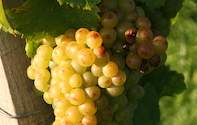Description
Muscadel in South Africa refers to the Muscat de Blanc à Petite Grains variety, which when translated means white Muscat with little berries.

It is regarded as one of the oldest existing wine-grape varieties. South Africa produces the classic white variety as well as a mutation, which is identical to the white variety except for having red berries. It is primarily used for the production of fortified wines.
Origins
Popular belief is that the Romans took this ancient Greek variety to France, where it was extensively planted in Frontignan. The variety, for this reason, is also known as Muscat de Frontignan.Other Names
Besides Muscat de Blanc à Petite Grains and Muscat Frontignan, the white variety is known as Gelber Muskateller in Germany and Muscat Canelli in California. The red variety is known as Brown Muscat in Australia.Production in South Africa
Muscadel was among the varieties used to produce South Africa’s first wine, back in 1659, a few years after Jan van Riebeeck’ s arrival in the Cape. White and red Muscadel, along with red Pontac, white Frontignac and Steen, also counted among the varieties that put Constantia’s natural sweet wines on the map around the 18th and 19th Century.
The wine became famous overseas, a favourite in the royal courts of Europe, with its praises sung by famous poets and writers. Jane Austen’s Mrs Jennings in Sense and Sensibility, for example, recommended a little “Constantia for its healing powers on a disappointed heart”, while Charles Baudelaire in his poem Les fleur du mal (Flowers of Evil) compared it to the charms of his beloved. Napoleon Bonaparte allegedly requested a bottle on his deathbed.
The era came to an end when Phylloxera, a sap sucking insect that destroyed most of the vines in the country, hit South Africa in 1886. From then on, vines were grafted onto rootstocks that were resistant to these insects, which at the time were imported from North America.
South Africa used to be one of only a few countries towards the 20th Century that produced more red than white Muscadel. The situation has changed over time, resulting in red Muscadel plantings more than halving since then.
Production Regions
While the area under production has significantly declined over the years, vineyards can still be found in most of the wine producing regions of the country. The Robertson Valley has the most Muscadel vineyards, accounting for more than half the area under production. The red variety thrives in the slightly alkaline, deep alluvial soils of the Klein Karoo, while the white variety performs better on loamy soils. Both varieties prefer warm dry climatic conditions.Growth and Ripening
The variety is not as vigorous as its cousin, Muscat d’ Alexandrie (also known as Hanepoot in South Africa). With an average yield of 15 t/ha to 20 t/ha, its production potential is also slightly lower. It ripens early mid-season, from the third week of February.
Berries and Leaves
The variety has small to medium sized, round berries. The white variety has a yellow green colour, while the colour of the red variety ranges from pale to dark red, depending on the clone. The leaves of both varieties are dark green, thick, round and three-lobed.